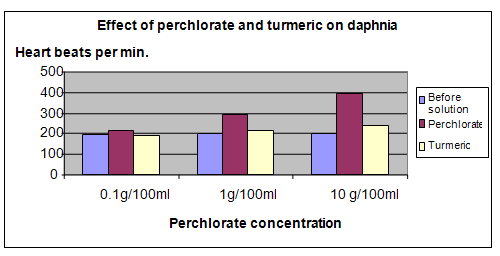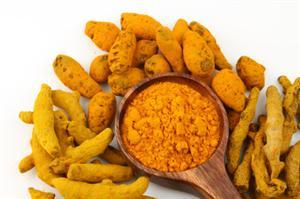| Complexity level: | 9 |
| Project cost ($): | 80 |
| Time required: | 1 hour to prepare, 6 hours for science fair project |
| Material availability: | Need |
| Safety concerns: | Basic safety requirements |
Hypothesis
Turmeric juice is able to counter the effects of exposing daphnia to perclorate solution.
Overview
Turmeric
Turmeric is a herb that is similar to ginger and is used in curries to give it a peppery flavor and yellow color. It is also known to have many medicinal properties and is widely used as an antiseptic in Indian and Chinese traditional medicine. It has been used to cure digestive problems, stomach aches and nausea.
Turmeric has the elements of both an antioxidant and an anti-inflammatory. It has been found to be useful in treating inflammations, arthritis and even preventing the spread of certain types of cancer. As a strong antioxidant, it also protects the cells in our bodies from damage by oxidation. The antioxidant properties of turmeric protect our brain, liver and kidney from damage from drugs, chemicals or alcohol.
Perchlorate
Perchlorates are salts that are obtained from perchloric acid. It is a reactive oxidizer and is known to obstruct the intake of iodine intake by our thyroid glands. This causes health problems because the thyroid gland releases hormones that control our rate of metabolism. Perchlorates are also used as medication to treat hyperthyroidism.
Scientific Terms
Materials
The materials required for this science fair project:
- 15 daphnia
- 3 beakers
- a bottle of perchlorate
- a bottle of turmeric juice
- a microscope
- 3 glass slides
- 1 digital weighing scale
- 1 stopwatch
- 300ml distilled water
- 1 measuring cylinder
- 1 bottle of eye drops
Procedure
1. For this science fair project, the independent variable is the concentration of perchlorate and turmeric juice. The dependent variable is the heart rate of the daphnia. This is determined by counting the number of heart beats per minute. The constants (control variables) are the amount of perchlorate, and the amount and concentration of turmeric juice.
2. The 3 beakers are labeled as 0.1g, 1g and 10g. Three concentrations of perchlorate solution are mixed into the 3 beakers.
a. 0.1g – 100ml of distilled water is mixed with 0.1gram of perchlorate
b. 1g 100ml of distilled water is mixed with 1.0 gram of perchlorate
c. 10g – 100ml of distilled water is mixed with 10 gram of perchlorate
3. The daphnia are separated onto the 3 slides. Each slide should have 5 daphnia organisms on its surface. The slides are placed under the microscope and the heart rates of the daphnia is counted. The average number of heart beats per minute is calculated by totaling the heart rates and dividing the total by 5.
4. On the first slide, 3 drops of perchlorate from the beaker marked 0.1g are placed on the slide. The slide is put aside for 30 minutes giving the daphnia a chance to react to the perchlorate solution. The slide is then placed under the microscope and the average number of heart beats per minute is again recorded. The results are recorded in the table below.
5. On the same slide, 3 drops of turmeric juice are added. The slide is again put aside for 30 minutes before counting the heart rate. The average heart rate for the 5 daphnia is calculated and recorded.
6. Procedures 4 and 5 are repeated using the second slide for the perchlorate marked 1g and the third slide for the perchlorate marked 10g. The average heart beat is recorded in the table given below.

Results
The results showed that adding perchlorate increased the heart rates of the daphnia while introducing the turmeric subsequently reduced their heart rates.
|
Daphnia heart rate per minute, after 30 minutes |
|||
|
0.1g/100ml |
1g/100ml |
10 g/100ml |
|
|
Before solution |
195 |
205 |
202 |
|
Perchlorate |
215 |
290 |
395 |
|
Turmeric |
192 |
215 |
238 |
The chart below summarizes the results of our science project experiment

Conclusion
Our hypothesis has been proven correct. Turmeric juice is able to counter the effects of exposing daphnia to perclorate solution.
Turmeric has been found to be useful as a herb used in cooking. It also has a lot of medicinal properties. Turmeric has been used for over 4000 years in India and China to heal various ailments. Recent research shows that turmeric is also able to prevent certain types of cancers from spreading.
Also consider
This science fair project can also be repeated using different types of herbs like garlic or ginger.
Try to repeat the science project experiment, this time varying the room temperature.
References
Turmeric the magical antioxidant and anti inflammatory spice - http://www.buzzle.com/articles/turmeric-the-magical-antioxidant-and-anti-inflammatory-spice.html
Perchlorate - http://en.wikipedia.org/wiki/Perchlorate
Daphnia - http://en.wikipedia.org/wiki/Daphnia

